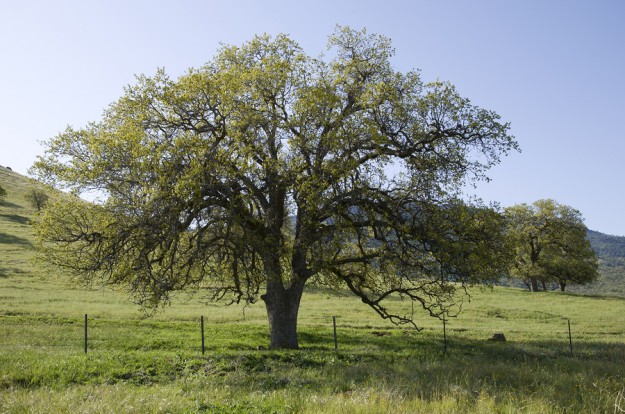
Last time we discussed trees here at the Scenic Wonders blog, we considered a conifer of the Sierra mountain forests: the
stately sugar pine. Today, let’s shift our focus to the lovely lowlands of Yosemite Valley and the tree that defines this place more than any other: the California black oak.
This hefty hardwood contributes an essential service to the valley’s world-famous scenery, conjuring a pastoral parkland beneath the huge granite walls. And—as this
Yosemite Nature Notes video notes—it has immense ecological and cultural significance here in the park and elsewhere in the Sierra Nevada.
It’s a great time to think about oaks, given the season: The fresh spring leaves, striking-looking with their crimson hairs, are beginning to emerge alongside the dangling catkins of the male flowers. The foliage cycle of the oaks—from spring red and summer green to autumn brown and winter barrenness—creates a very conspicuous calendar against the evergreen stability of Yosemite’s myriad conifers.
The autumn mast—the oaks’ production of acorns—is a major event for many creatures in Yosemite Valley, from ground squirrels and band-tailed pigeons to mule deer and black bears. One of Yosemite’s most beautiful birds, the
acorn woodpecker (as the name suggests) harvests the nuts with real gusto. They’ll pack the holes they drill out in tree branches with acorns—a cache for later consumption.
For thousands of years, woodpeckers and deer and bears were joined in the mast by American Indians. The Miwok and other Yosemite-area tribes collected droves of acorns and mashed them in bedrock “mortars” into a flourlike meal. Writing in
Discovering Sierra Trees, Stephen Arno noted, “It is no coincidence that California Indians chose sites like Yosemite and Kings Canyon for their summer encampments. To them black oak groves were like our wheatfields.”
You can learn more about the importance of black oaks to the indigenous residents of the Sierra at the
Indian Village of Ahwahnee, which displays pounding rocks and reconstructed acorn granaries.
The fat-trunked, wide-crowned black oaks of Yosemite Valley—which may be declining, a focus of
Park Service research—are treasures. Next time you’re staying with us at Scenic Wonders, go out and appreciate these centuries-old veterans!

 Last time we discussed trees here at the Scenic Wonders blog, we considered a conifer of the Sierra mountain forests: the stately sugar pine. Today, let’s shift our focus to the lovely lowlands of Yosemite Valley and the tree that defines this place more than any other: the California black oak.
This hefty hardwood contributes an essential service to the valley’s world-famous scenery, conjuring a pastoral parkland beneath the huge granite walls. And—as this Yosemite Nature Notes video notes—it has immense ecological and cultural significance here in the park and elsewhere in the Sierra Nevada.
It’s a great time to think about oaks, given the season: The fresh spring leaves, striking-looking with their crimson hairs, are beginning to emerge alongside the dangling catkins of the male flowers. The foliage cycle of the oaks—from spring red and summer green to autumn brown and winter barrenness—creates a very conspicuous calendar against the evergreen stability of Yosemite’s myriad conifers.
The autumn mast—the oaks’ production of acorns—is a major event for many creatures in Yosemite Valley, from ground squirrels and band-tailed pigeons to mule deer and black bears. One of Yosemite’s most beautiful birds, the acorn woodpecker (as the name suggests) harvests the nuts with real gusto. They’ll pack the holes they drill out in tree branches with acorns—a cache for later consumption.
For thousands of years, woodpeckers and deer and bears were joined in the mast by American Indians. The Miwok and other Yosemite-area tribes collected droves of acorns and mashed them in bedrock “mortars” into a flourlike meal. Writing in Discovering Sierra Trees, Stephen Arno noted, “It is no coincidence that California Indians chose sites like Yosemite and Kings Canyon for their summer encampments. To them black oak groves were like our wheatfields.”
You can learn more about the importance of black oaks to the indigenous residents of the Sierra at the Indian Village of Ahwahnee, which displays pounding rocks and reconstructed acorn granaries.
The fat-trunked, wide-crowned black oaks of Yosemite Valley—which may be declining, a focus of Park Service research—are treasures. Next time you’re staying with us at Scenic Wonders, go out and appreciate these centuries-old veterans!
Last time we discussed trees here at the Scenic Wonders blog, we considered a conifer of the Sierra mountain forests: the stately sugar pine. Today, let’s shift our focus to the lovely lowlands of Yosemite Valley and the tree that defines this place more than any other: the California black oak.
This hefty hardwood contributes an essential service to the valley’s world-famous scenery, conjuring a pastoral parkland beneath the huge granite walls. And—as this Yosemite Nature Notes video notes—it has immense ecological and cultural significance here in the park and elsewhere in the Sierra Nevada.
It’s a great time to think about oaks, given the season: The fresh spring leaves, striking-looking with their crimson hairs, are beginning to emerge alongside the dangling catkins of the male flowers. The foliage cycle of the oaks—from spring red and summer green to autumn brown and winter barrenness—creates a very conspicuous calendar against the evergreen stability of Yosemite’s myriad conifers.
The autumn mast—the oaks’ production of acorns—is a major event for many creatures in Yosemite Valley, from ground squirrels and band-tailed pigeons to mule deer and black bears. One of Yosemite’s most beautiful birds, the acorn woodpecker (as the name suggests) harvests the nuts with real gusto. They’ll pack the holes they drill out in tree branches with acorns—a cache for later consumption.
For thousands of years, woodpeckers and deer and bears were joined in the mast by American Indians. The Miwok and other Yosemite-area tribes collected droves of acorns and mashed them in bedrock “mortars” into a flourlike meal. Writing in Discovering Sierra Trees, Stephen Arno noted, “It is no coincidence that California Indians chose sites like Yosemite and Kings Canyon for their summer encampments. To them black oak groves were like our wheatfields.”
You can learn more about the importance of black oaks to the indigenous residents of the Sierra at the Indian Village of Ahwahnee, which displays pounding rocks and reconstructed acorn granaries.
The fat-trunked, wide-crowned black oaks of Yosemite Valley—which may be declining, a focus of Park Service research—are treasures. Next time you’re staying with us at Scenic Wonders, go out and appreciate these centuries-old veterans! 







